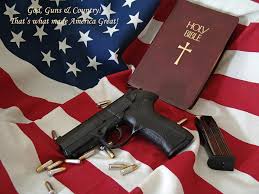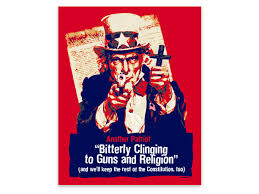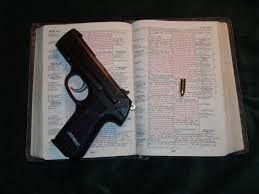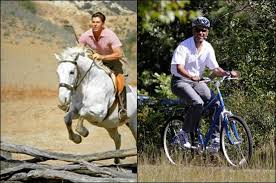
More pertinent images at bottom of post
Churches wrestle with guns in the pews
2/14/2011
The way Rev. Jonathan Wilkins sees it, members of his Baptist church in Thomaston, Ga., should have the right to carry guns into worship services to protect the congregation.
The way Rev. Jonathan Wilkins sees it, members of his Baptist church in Thomaston, Ga., should have the right to carry guns into worship services to protect the congregation.
By Kevork Djansezian, Getty Images
Wilkins' Baptist Tabernacle and a Georgia gun-rights association are challenging a new state law that prohibits weapons in houses of worship. A lower court ruled against them in January; the case is now headed for appeal.
"What we're fighting for is not that just any old body can carry guns in church," Wilkins said. "We would be responsible. We would want people who are trained, and so forth, to carry, people that we designate for protective purposes."
Recently, state legislatures in Georgia, Michigan andLouisiana have been caught in the crossfire of the debate between gun rights and gun control as they consider allowing weapons in houses of worship.
Though gun-rights proponents think they have both the First and Second Amendments on their side, they also cite the rights of religious organizations as property owners. Opponents, meanwhile, worry that having weapons in worship is part of a slippery slope to permitting them everywhere.
A month after then-Georgia Gov. Sonny Perdue signed the 2010 law listing places of worship among "unauthorized" locations for carrying weapons, Louisiana Gov. Bobby Jindal took the opposite tack. Louisiana law now permits trained worshippers to bring guns into churches, mosques and synagogues as long as fellow congregants are informed.
Meanwhile, other states are mulling whether to scale back restrictions on weapons.
In Michigan, gun rights activists are pushing for a change in the law that would make it possible to carry guns in worship without prior permission from a presiding official.
Mike Thiede, spokesman for Michigan Gun Owners and a member of a Baptist church, said he spoke to legislators in favor of changing the law after a church secretary was assaulted and a pastor was tied up during a robbery at another church.
"I just thought it was a terrible situation for people to be in," he said. "Outside that door, they could protect themselves but inside that door, they could be a victim."
Other crimes have prompted greater interest in new legislation. In 2009 alone, abortion doctor and usher George Tiller was shot in the foyer of his Lutheran church in Kansas; the Rev. Fred Winters was killed in his Illinois pulpit; and the Rev. Carol Daniels was found dead in her Oklahoma church.
"When you see things like that happening over and over again, churches are saying, 'What are we supposed to do?'" said Jeffrey Hawkins, executive director of the Virginia-based Christian Security Network.
Hawkins' organization reported seven homicides in churches in 2010, but while he supports crime prevention techniques, Hawkins does not advocate worshippers carrying guns into church.
"You go into somewhere crowded, like a church, and there's three people who have guns out that are shooting at each other," he said. "How's the police officer going to be able to discern who's ... the bad guy?"
Laura Cutilletta, senior staff attorney of the San Francisco-based Legal Community Against Violence, said many states remain silent on weapons and worship. But she said gun lobbyists have become more vocal advocates for permitting weapons not only in churches but in other public places, such as parking lots and bars.
"Guns don't have a place in public, especially places like churches and bars and places where a lot of people are congregating," she said. "An unintentional shooting could end up injuring many people."
Laws about weapons in houses of worship vary widely. Some states forbid firearms in religious buildings but others permit them unless a congregation has posted a sign disallowing them. Still others say they're permitted if the pastor, priest or rabbi gives the OK.
And the penalties are just as varied, with some "like a traffic ticket" and other violations considered a felony, Hawkins said.
In Virginia, carrying a gun in a house of worship is allowed unless there's a service being conducted. If there is a service, "good and sufficient reason" — a term left undefined in the code — is required.
"We think our law is actually broad enough that there's no great urgency to try to change it," said Philip Van Cleave, president of the Virginia Citizens Defense League, a gun rights group.
In Mississippi, several bills introduced this year to remove churches from a list of prohibited places for weapons died in committee, but at least one continues to be debated.
"It seems to me that our law that explicitly prohibits acts in a church that are perfectly legal outside the church clearly violates the First Amendment in addition to the Second," said Jeff Pittman, vice president of the Mississippi State Firearm Owners Association

"Risks and Benefits of a Gun in the Home"









Why doesn't the silly person on the right become a cowboy?



British Police and Guns
http://en.wikipedia.org/wiki/Police_use_of_firearms_in_the_United_Kingdom

"The Geography of Gun Death," The Atlantic
***
"Risks and Benefits of a Gun in the Home"
David Heminway, Ph.D. Harvard School of Public Health
***
In 2005, 86% of firearm-related deaths in California's Shasta County were suicides.
***




Why doesn't the silly person on the right become a cowboy?


British Police and Guns
http://en.wikipedia.org/wiki/Police_use_of_firearms_in_the_United_Kingdom
Excerpt:
History
Police use of firearms in the United Kingdom has been a slow, controversial[4] and developing process as senior officers wanted their forces to still have the "British Bobby" or Dixon of Dock Green effect on the community.[4] During the Second World War, firearms were only carried while protecting 10 Downing Street and the Royal Family, but police were given many firearms in case of invasion.[4] They were never taken on general patrol, partly because a revolver was usually issued without a holster,[4] as holsters were in short supply because of the war.[4]Training for the Webley & Scott Revolvers usually consisted of firing six shots and to pass, it was required that three shots had to be on target although loading of the actual weapon was not taught.[4] In 1948, after the Second World War Concerns were aired by the Home Officeof the police forces role of another war or nuclear attack,[4] to combat this it was decided that some of the forces would be loaned Sten Gunsby the Ministry of Defence and a number of Lee Enfield No4 Mk 2s. These, along with revolvers and ammunition, were kept in secret depots around the United Kingdom so every force had the weapons close and could get access to them when and if the time should come.[4]
Historically, officers on night patrols in some London divisions were frequently armed with Webley revolvers. These were introduced following the murder of two officers in 1884, although individual officers were able to choose whether to carry the weapons. Armed police were rare by the turn of the century, and were retired formally in July 1936. Although, after the Battle of Stepney in 1911, Webley semi-automatics were issued to officers. From the 1936 date on, firearms could only be issued by a Sergeant with good reason, and only then to officers who had been trained in their usage.
The issue of routine arming was raised after the 1952 Derek Bentley case, in which a Constable was shot dead and a Sergeant severely wounded, and again after the 1966 Massacre of Braybrook Street, in which three London officers were killed. As a result, around 17% of officers in London became authorised to carry firearms. After the deaths of a number of members of the public in the 1980s fired upon by police, control was considerably tightened, many officers had their firearm authorisation revoked, and training for the remainder was greatly improved. As of 2005, around seven per cent of officers in London are trained in the use of firearms. Firearms are also only issued to an officer under strict guidelines.[5]
In order to allow armed officers to respond rapidly to an incident, most forces have patrolling Armed Response Vehicles (ARVs). ARVs were modelled on the Instant Response Cars introduced by the West Yorkshire Police in 1976, and were first introduced in London in 1991, with 132 armed deployments being made that year.
Although largely attributable to a significant increase in the use of imitation firearms and air weapons,[6] the overall increase in firearms crime between 1998/99 and 2002/03[6] (it has been decreasing since 2003/04, although use of imitations continued to rise)[6] has kept this issue in the spotlight. In October 2000, Nottinghamshire Police introduced regular armed patrols to the St Ann's and Meadows estates in Nottingham, in response to fourteen drug-related shootings in the two areas in the previous year.[7] Although the measure was not intended to be permanent, patrols were stepped up in the autumn of 2001 after further shootings,[8] after which the firearms crime declined dramatically.[9]
As of September 2004, all forces in England and Wales have access to tasers, but they may only be used by Authorised Firearms Officers(AFO's) and specially trained units. The Police Federation have since called for all officers to be issued with tasers, with some public support.[10]
In 2010, following the serious injury of an unarmed officer in a knife attack, the chairman of the Police Memorial Trust, Michael Winner stated that he had put up memorials to 44 officers and that he believed, "It is almost certain that at least 38 of those [Police Officers] would be alive had they been armed".[11] In response, chairman of the Metropolitan Police Federation Peter Smyth said, "A lot of police officers don't want to be armed. We don't want a call to arms, I don't think that's necessary."[12]
Police Federation surveys have continued to show police officers' considerable resistance to routine arming. In the Federation's most recent (2006) Officer/Arming survey, 82% of respondents were against the routine arming of police, although 43% supported an increase in the number of officers trained and authorised to use firearms.[13]
***
***
Unless people have sufficient faith to dis-arm, there will be no disarmament.
Any collective movement in the direction of peace is always predicated on acts of faith: someone decides to run a definable risk by behaving faithfully rather than fearfully.
Any collective movement in the direction of peace is always predicated on acts of faith: someone decides to run a definable risk by behaving faithfully rather than fearfully.
Absent faith in disarmament, people will (if law permits) arm themselves in ever greater numbers.
The experience of British law enforcement embeds a value system that is essential for Civilization, whereas Americans' passion for firearms -- whatever near-term benefits may accrue -- inclines the United States toward barbarism.
In my view, the 2nd Amendment should remain intact but it should be read literally: "A well regulated militia, being necessary to the security of a free state, the right of the people to keep and bear arms, shall not be infringed."
My literal reading is that a citizen's right to bear arms derives from the prior political need to maintain "a well regulated militia."
Since the Founding Fathers were uniformly opposed to the maintenance of "standing armies," they perceived need for well-regulated citizen militias which could be quickly mustered in time of threatening war.
Outside the overarching domain of "a well regulated militia" there is no constitutional authorization that individuals have a right to bear arms.
Rather, it is the stated intent of the 2nd Amendment that arms-bearing citizens first be integrated into "well regulated militias."
Prior integration into "well regulated militias" was also the contextualized intent of the Founding Fathers.
"Security is mostly a superstition.
It does not exist in nature,
nor do the children of men as a whole experience it.
Avoiding danger is no safer in the long run than outright exposure.
Life is either a daring adventure, or nothing."
-- Helen Keller
(1880-1968) Blind-Deaf Author
Source: The Open Door, 1957
***

No comments:
Post a Comment